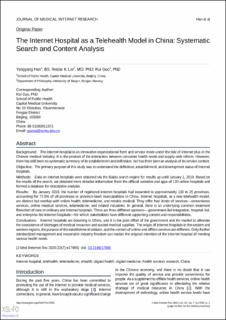| dc.description.abstract | Background: The internet hospital is an innovative organizational form and service mode under the tide of internet plus in the Chinese medical industry. It is the product of the interaction between consumer health needs and supply-side reform. However, there has still been no systematic summary of its establishment and definition, nor has there been an analysis of its service content.
Objective: The primary purpose of this study was to understand the definition, establishment, and development status of internet hospitals.
Methods: Data on internet hospitals were obtained via the Baidu search engine for results up until January 1, 2019. Based on the results of the search, we obtained more detailed information from the official websites and apps of 130 online hospitals and formed a database for descriptive analysis.
Results: By January 2019, the number of registered internet hospitals had expanded to approximately 130 in 25 provinces, accounting for 73.5% of all provinces or province-level municipalities in China. Internet hospitals, as a new telehealth model, are distinct but overlap with online health, telemedicine, and mobile medical. They offer four kinds of services—convenience services, online medical services, telemedicine, and related industries. In general, there is an underlying common treatment flowchart of care in ordinary and internet hospitals. There are three different sponsors—government-led integration, hospital-led, and enterprise-led internet hospitals—for which stakeholders have different supporting content and responsibilities.
Conclusions: Internet hospitals are booming in China, and it is the joint effort of the government and the market to alleviate the coexistence of shortages of medical resources and wasted medical supplies. The origin of internet hospitals in the eastern and western regions, the purpose of the establishment initiator, and the content of online and offline services are different. Only further standardized management and reasonable industry freedom can realize the original intention of the internet hospital of meeting various health needs. | en_US |

